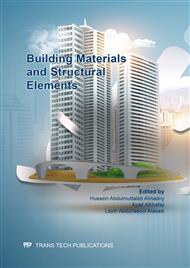p.77
p.88
p.97
p.110
p.121
p.130
p.139
p.147
p.157
White Clay Ceramic Tableware Waste as Coarse Aggregate in Concrete - Some Mechanical Properties and Durability against Fire and Sulfate Attack
Abstract:
The aim of study is to produce durable structural concrete by using waste ceramics with specified type (white clay ceramics) as coarse aggregates in concrete. Mechanical properties were studied, the study also show good resistance to fire resistance for concrete contains ceramics as coarse aggregates compared with normal aggregates concrete, good mechanical properties such as compressive, tensile, and flexural strength. Results of study gave 17.5% increment in compressive strength by using 100% replacement of waste ceramic, flexural strength increased with 27.8% increment. Study also show less reduction in strength due to fire resistance by using waste ceramics compared to ordinary concrete, and also more durable concrete for salty water effects by using ceramic.
Info:
Periodical:
Pages:
121-129
Citation:
Online since:
August 2021
Keywords:
Price:
Сopyright:
© 2021 Trans Tech Publications Ltd. All Rights Reserved
Share:
Citation:


